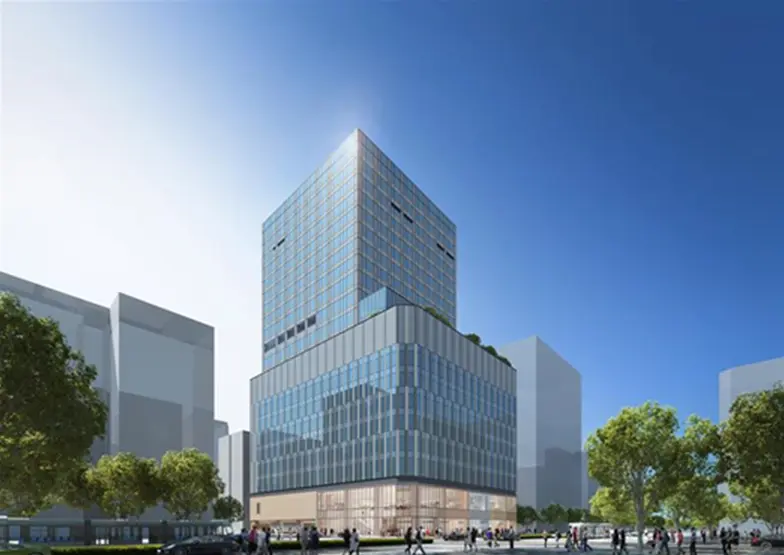News
May 30th, 2025
- Sapporo
- Sustainability
Sapporo Daibiru Building Becomes the Ninth Certified- Sapporo
- Sustainability
“Zero Carbon Promotion Building” in Sapporo City
DAIBIRU CORPORATION (President & CEO: Takashi Maruyama; Head office: Kita-ku, Osaka; hereinafter, the “Company”) hereby gives notification that the Sapporo Daibiru Building (hereinafter, the “Building”), which the Company has promoted as a redevelopment project for some time, has now been certified as a “Zero Carbon Promotion Building” by the City of Sapporo.

Zero Carbon Promotion Building refers to a property that satisfies certain criteria in contributing to decarbonization as certified by the City of Sapporo, subject to conditions such as receiving a high evaluation in discussions based on the Sapporo Downtown “E! MACHI” Urban Development Promotion System.
At the Building, measures have been instituted to control environmental load as a means of combating climate change as well as measures to ensure business continuity in the event of emergencies, while the office floors have acquired “ZEB Oriented” ranking in the Building-Housing Energy-Efficiency Labeling System (BELS).*1 In addition, as an initiative toward decarbonization, the building is scheduled to introduce CO2-free electricity*2 and has been highly evaluated for the incorporation into its development plan of initiatives that will contribute to enhancing the value of downtown Sapporo under the Sapporo Downtown “E! MACHI” Urban Development Promotion System, which has now resulted in the acquisition of this certification. Currently, nine properties, including the Building, have been certified as Zero Carbon Promotion Buildings in Sapporo City.
- *1 A third-party certification system that grants labeling denoting the energy-saving performance of buildings
- *2 Electricity substantially derived from renewable energy sources with net-zero CO2 emissions as proven through non-fossil fuel energy certificates
Tenants occupying a Zero Carbon Promotion Building who satisfy certain criteria may also be eligible to receive rent subsidies of up to 200 million yen from Sapporo City. For more details, please refer to the information guide on these subsidies.
NEXT SAPPORO Comprehensive Navigator for Enterprises (Japanese)
The Company aims to continue to contribute to the local community and the people of Sapporo City by creating environmentally friendly buildings and providing safe and secure spaces and environments going forward.
Overview of the Plan
| Name of building | Sapporo Daibiru Building | ||||
|---|---|---|---|---|---|
| Location | Minami 2-jo Nishi 4-chome 11, Chuo-ku, Sapporo, Hokkaido | ||||
| Access |
|
||||
| Site area | 3,143 m² | ||||
| Gross floor area | Approx. 42,000 m² | ||||
| Number of floors | 19 floors above ground, 2 floors below ground | ||||
| Structure | Steel-frame structure (partly steel-frame ferroconcrete structure) | ||||
| Uses | Offices and some shops; hotel | ||||
| Design management | Nikken Sekkei Ltd. | ||||
| Construction | Obayashi Corporation | ||||
| Completion | End of April 2027 (scheduled) |
Location
The plan is to construct the new building on the site of the former Daibiru Pivot, which closed at the end of May 2023, and other buildings. It is expected that the large-scale redevelopment projects taking place one after the other in Sapporo will boost the number of domestic and international visitors to the city and generate even more liveliness in surrounding areas.
Furthermore, the project site is a location at which business and commercial functions converge, and is 100 meters from Odori Station, where three subway lines connect, while also providing the convenience of direct access to the underground, which is especially important in a cold and snowy region. The project will thus contribute to the creation of a lively atmosphere in the city by drawing on this potential to the full.
Concept
Based on the concept of “creating and spreading links,” this project will connect “things” through collaboration among the various businesses engaged in commercial, office, and hotel operations; “people” through interaction between local residents and visitors from outside Hokkaido; and “time” through Sapporo’s history, culture, and future development. By expanding the synergy born therefrom, we will construct a landmark building that will blow a fresh breeze throughout the city of Sapporo.
The exterior of the building will express the three-way diversity through a combination of differing designs. By facilitating redevelopment of the surroundings and differentiation, we will endeavor to create a new scene in Sapporo.
Building Profile
(1) Lower floors (shops and restaurants)
The lower floors will be a commercial facility comprising shops with three differing characteristics—those in the maisonette zone along Ekimae-dori avenue, those in the B2 basement zone, and those in the northside zone along Naka-dori avenue (commonly known as Oyoyo-dori). The maisonette zone along Ekimae-dori avenue will feature street-facing shops that will add a splash of color to the area with their brand displays; the B2 basement zone will have shops open to the basement plaza served by escalators following the daily flow lines; and in the north-side zone along Naka-dori avenue we will create a high-density bustling space with a concentration of small-scale lots. We are planning to build a commercial facility that is open to the community.
(2) Middle floors (offices)
The offices on the middle floors (3F–8F) will occupy shapely space looking out broadly over Ekimae-dori, Minami 2-jo, and Naka-dori avenues. By concentrating the equipment space on the core side, while ensuring adequate depth, we will create highly flexible office space that is easily adaptable to subdivision.
(3) Upper floors (hotel)
The TRUNK (HOTEL), a luxury boutique hotel venture of the major Japanese wedding company TAKE and GIVE NEEDS Co., Ltd. (Shinagawa-ku, Tokyo; President and Representative Director Kenji Iwase), is scheduled to open for business on the upper floors. While the first TRUNK (HOTEL) opened in Jingumae, Tokyo in 2017, with a second branch then opened in Yoyogi Park, Tokyo in September 2023, this will mark the first branch of this hotel to open in Hokkaido.
Features
(1) Business continuity plan
- The building structure will adopt seismic control systems, including vibration control braces and oil dampers, to ensure robust earthquake-resistant performance. Safety verifications have been carried out for massive ground motions up to 1.5 times that stipulated in the Building Standards Act as well as inland earthquakes directly below Tokyo, equivalent to the “Excellent” grade in the earthquake-resistant performance ratings of the Japan Structural Consultants Association (JSCA).
- As a response in times of power failure, the building will have an emergency generator operable for 72 hours, so electricity can be supplied for main functions, such as disaster-prevention equipment, lighting, and toilets, and for some rental rooms. Also, it will be possible to supply water for continued use over 10 days.
- There are plans to provide temporary-stay space for 100 persons unable to return home in the event of a disaster, as well as a storeroom for disaster-prevention equipment, in the B2 basement plaza (“Communal Lounge”).
(2) Environmental performance
- The building will control its environmental load by employing highly efficient heat sources, a water-conveyance system by large temperature differences, a district heating and cooling system, low-emissivity multilayer glass, and so on.
- As an initiative toward decarbonization, the building is scheduled to introduce CO2-free electricity.
SDGs Relevant to This Project
Map of Building’s Location

Contact Information
Sapporo Project Department, Daibiru Corporation
TEL: (+81)-11-218-0111









